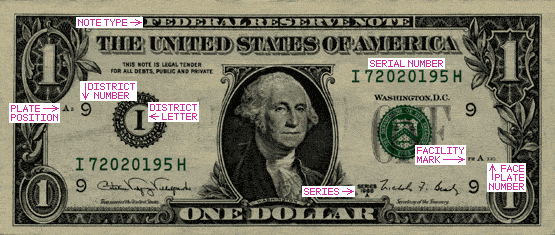All modern United States currency contains either a 10- or 11-digit serial number in order to make each bill unique. Ten-digit serial numbers were on all bills until the 'new style' came out in 1996. Those bills (and all produced since then) have an 11-digit serial. The serial number consists of the following:
- The first letter, only found on the new-style bills, represents the series of the bill. The series indicates the year in which the design of the bill was approved for production. This begins with A, and moves through the alphabet each time a new series is needed (for example, each time there is a new secretary of the treasury, the bill design changes because the secretary's signature is on all currency). You can also find the series of the bill printed directly to the bottom-right of the portrait.
- The second letter (or first, if you're looking at an old-style bill) represents the district of the Federal Reserve Bank that your bill was issued from. As there are 12 Federal Reserve Banks, this letter can range from A to L, with A representing Boston, MA, and L representing San Francisco, CA.
- The eight numerical digits that follow represent a unique ID number. This number increases sequentially as each bill is printed. Using these digits alone, there would be a possible 99,999,999 bills issued per bank.
- The final letter is used to raise the number of possible bills beyond 99,999,999. Altogether, there are a possible 2,499,999,975 serial numbers for each bank!
Serial number ranges for the web press notes that the BEP was printing a number of years ago. Partial data on the serial ranges for the SOI $20 notes in Series 2006 through 2013. Partial data on the serial ranges for the LEPE vs. COPE $2 notes in Series 2013. Solid Serial Numbers on Currency – Values and Pricing. Not every series of currency is printed to full capacity, so the higher numbers tend to be rarer than the smaller numbers. Solid Serial number 9s are extremely rare. Today currency is only printed up to serial number 96000000, so solid 9s can only be found on older issues. After solid 9s.
On occasion, a bill shows up that has a small star in place of the final letter in the serial.
Star After Serial Number On Us Currency
This star represents what is known as a replacement note. When a printing error occurs during a normal press run and renders a set of bills unusable, replacement notes are used instead. With replacements notes, a set of serial numbers can still have the proper number of bills even if some of the original bills had to be pulled. The replacement notes have a sequence of their own, using the star as their final 'letter.' This allows for 99,999,999 possible replacement notes for any given bank, series and denomination. This should be more than enough: According to the Paper Money Collecting FAQ, there's about one error in every 100,000 U.S. bills.
In general, replacement notes aren't worth more than regular bills. However, if you find a replacement note with a particularly interesting serial number -- like 00000001 or 999999999 -- or a large number of consecutively numbered replacement notes that you keep together as a lot, you may have a collector's item on your hands.

Collectible Serial Numbers On Money
Here are some interesting links: